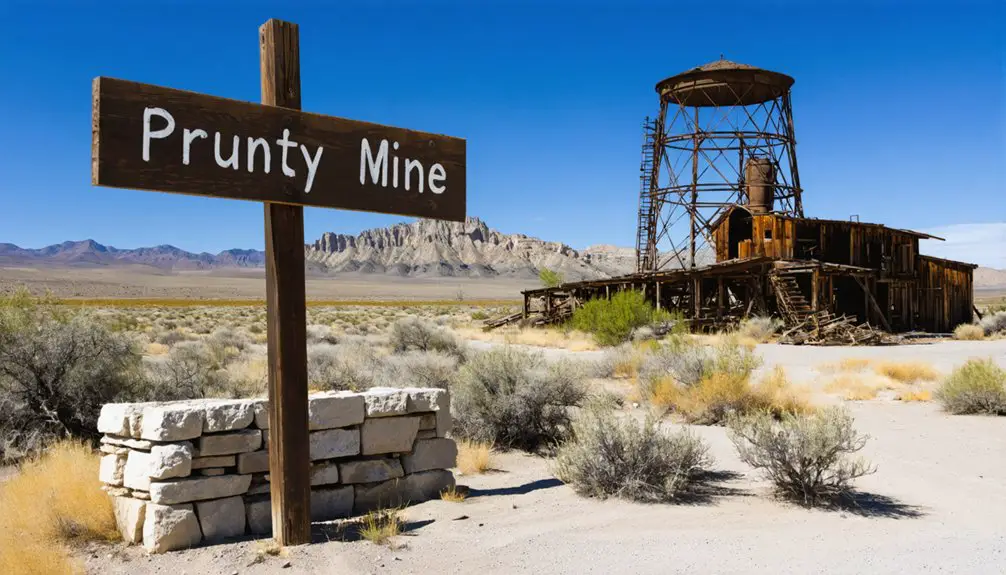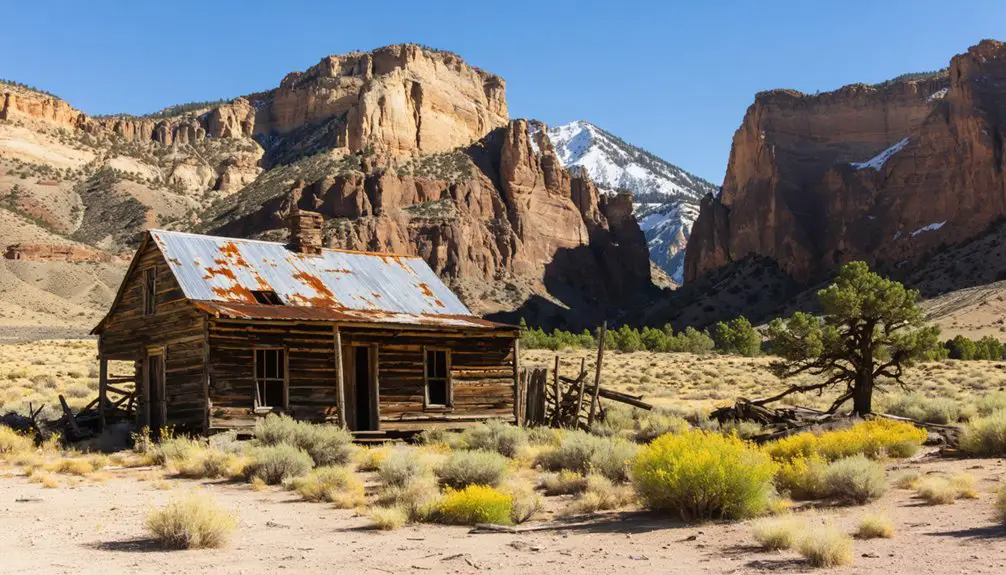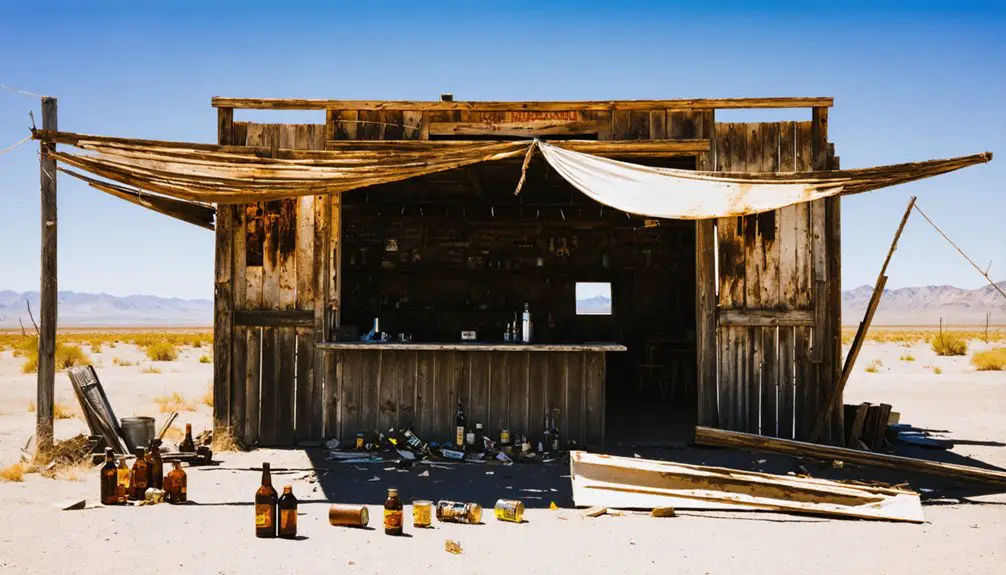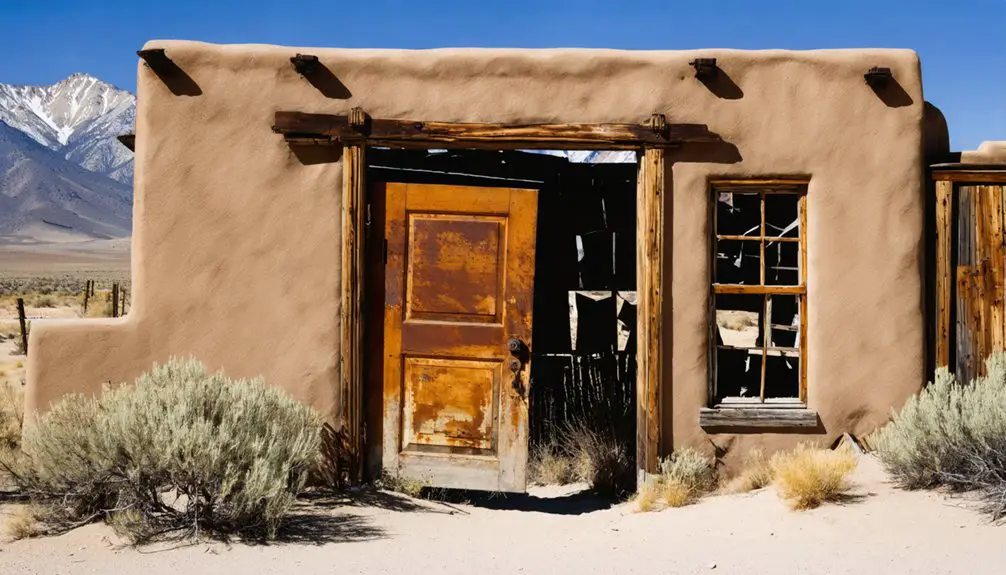You’ll discover Charleston, Nevada as a fascinating ghost town that began as “Mardis” during the early 1900s gold rush. The settlement peaked at 1,500 residents before experiencing typical mining boom-bust cycles, with deep shafts reaching 200 feet. The town’s story includes a dramatic name change, the influential Prunty family’s mining dynasty, and an eventual shift to ranching. Today, two historic buildings remain on private property, marking a rich chapter in Nevada’s mining heritage.
Key Takeaways
- Charleston was a gold mining town established in the 1870s in Nevada, originally named Mardis, with a peak population of 1,500 residents.
- The town’s mining operations included deep shafts reaching 200 feet, producing gold from Cretaceous-age veins along Seventy-Six Creek.
- The Prunty family controlled local mining operations around 1900, later transitioning the area to successful ranching operations.
- Two historic buildings remain on private property today, with most original structures gone from Charleston’s mining heyday.
- The ghost town requires special permits for visits due to a Forest Closure Order and is accessible via forest service roads.
The Birth of Mardis: A Gold Rush Settlement
As Nevada’s mining frontier expanded in the early twentieth century, the settlement of Mardis emerged during a period of intense gold exploration and discovery.
You’ll find its origins tied to promising strikes that drew prospectors to what would later become Charleston, Nevada. The rush brought waves of fortune-seekers, with the population swelling to over 1,500 before quickly settling at more modest numbers.
The settlement’s development centered around both placer and hardrock gold extraction methods, reflecting the era’s mining technology. Similar to other mining operations of the time, deepest shafts sunk reached depths of 200 feet.
You’d have seen claims staked rapidly as news spread of the discoveries, while miners established rudimentary infrastructure to support their operations. Like many Nevada settlements in the early 1900s, Mardis experienced the typical boom-bust cycles characteristic of mining towns.
The settlement’s success hinged on ore quality and the practical challenges of processing and shipping the extracted gold to distant smelters.
From Mardis to Charleston: The Name Change Story
The story behind Charleston’s name reveals a tale of tragedy and renewal in Nevada’s mining history. After the murder of town founder George Washington Mardis by a Chinese miner in the 1880s, the settlement’s population plummeted, nearly vanishing by 1883.
The name significance shifted in the 1890s when the town was rechristened Charleston, after local miner Tom Charles, marking a pivotal transformation in the community’s identity.
The town’s rebirth as Charleston honored miner Tom Charles, marking a fresh chapter in its evolving frontier story.
This change symbolized more than just a new name – it represented the community’s resilience as it evolved from a rough gold rush outpost into a more diverse settlement. The town became a bustling hub with schools and stores dotting its streets.
With the arrival of the Prunty family and other ranchers around 1900, Charleston embraced both mining and ranching, ensuring its survival despite ongoing population fluctuations. The town maintained a steady presence until post office closure in 1951 marked the end of an era.
Mining Booms and Busts Through the Years
You’ll find Charleston’s first mining boom started in 1855 when lead ore was discovered at the Potosi mine, establishing what would become the first smelter west of the Missouri River.
By 1910, the camp’s high-grade ore production exceeded $650,000, marking one of the region’s most profitable mining ventures of that era.
The area experienced another significant revival during the Tonopah silver boom of 1901, which triggered new mining rushes and the formation of Clark County in 1909. Like the Comstock Lode discovery of 1859, this development brought renewed interest in Nevada’s mineral wealth.
The Prunty family played an essential role in Charleston’s mining history, operating claims through multiple cycles of boom and bust, including the challenging period following World War I when many mining operations collapsed due to depleted ore deposits.
Early Gold Rush Era
Gold fever struck Charleston’s rugged terrain in 1876 when prospectors first discovered placer deposits along Seventy-Six Creek in Nevada’s Elko County.
You would’ve found early miners working the stream gravels with basic tools, extracting what would amount to roughly 300 ounces of gold before 1900.
The precious metal originated from Cretaceous-age veins in Paleozoic rocks near Copper Mountain, where granitic intrusions had created the perfect conditions for gold mineralization.
Though you’ll find that Charleston never reached the epic scale of the Comstock Lode rush, local prospectors remained persistent in their pursuit of riches. Like many areas across the state that helped establish Nevada as the top producer of gold in America, prospectors here dreamed of striking it rich.
They expanded their operations to Badger Creek and Bruneau River, though larger ventures proposed in 1907 and 1932 ultimately failed to materialize.
The town of Charleston established itself four miles south of the original placer mining sites, becoming a hub for local mining activity.
Second Mining Revival
While Charleston’s initial gold rush had faded by 1900, a second mining revival emerged under the leadership of the Pinkard Prunty family, who dominated local mining operations for the next four decades.
You’ll find that mining techniques evolved considerably during this period, changing from simple placer operations to more sophisticated underground mining methods. The district yielded an impressive array of minerals including gold, silver, copper, antimony, lead, zinc, tungsten, uranium, and barite.
Economic fluctuations heavily influenced Charleston’s fortunes, with metal prices and accessibility determining the success of mining ventures. Despite promotional efforts and periodic surges in activity, the town’s population remained modest. The area’s remote location, being 66 miles from Owyhee, made it challenging to sustain consistent mining operations.
Prunty Family Mining Legacy
After arriving in Charleston around 1900, the Pinkard Prunty family established a mining dynasty that would shape the region’s fortunes for four decades.
You’ll find that Prunty Mining controlled most operations near Charleston, with Pinkard supplementing income by gathering wild mustangs. The economic impact of their endeavors kept the town alive through erratic production periods, with miners earning $5.50 per shift and ore processing costs around $7 per ton in the 1920s. The ranch eventually evolved into a successful operation when they shifted focus to raising quality horses.
- The twelve Prunty children grew up learning the demanding ways of both mining and ranch life.
- Their father’s determination to seek gold fortune shaped Charleston’s development.
- The family’s innovative approach combined mining with mustang gathering to survive tough times.
- They built essential infrastructure, including power lines and wagon roads.
- Their legacy lives on through the shift from mining to ranching operations.
The Influential Prunty Family Legacy

Since their arrival in 1900, the Prunty family transformed Charleston from a mining camp into a thriving ranching empire that would span generations.
Led by Pinkard Prunty and his twelve children, they initially focused on gold mining but soon expanded into ranching under Earl Q. Prunty’s vision. Their ranching innovations included developing prestigious horse herds for rodeos and cavalry remounts.
Under Earl Q. Prunty’s leadership, the family expanded from mining into pioneering ranching, breeding exceptional horses for both rodeos and military service.
When Marge married Frank “Shorty” Prunty in 1948, their partnership strengthened the ranch’s legacy. While Shorty excelled as a stock contractor and hunting guide, Marge taught at the local schoolhouse for 17 years.
Today, you’ll find their legacy thriving at the remote ranch, located 85 miles northeast of Elko, where a colorful herd of 150 horses roams – a symbol of their pioneering spirit.
Life in Early Charleston: Commerce and Community
When prospectors discovered placer gold at Seventy-Six Creek in 1876, Charleston quickly transformed from empty terrain into a bustling frontier town.
The community dynamics reflected both cooperation and tension as miners, families, and merchants carved out their roles in this remote outpost. You’d find the town’s economic resilience in its diverse establishments – from saloons and hotels serving as social hubs to an early schoolhouse demonstrating commitment to education.
- The haunting echoes of barroom brawls and miners’ dreams still linger in Charleston’s abandoned streets.
- George Washington Mardis’s trusted ore-hauling operations connected isolated Charleston to the outside world.
- Determined families built a schoolhouse, defying the town’s wild reputation.
- Local businesses fought to maintain civilization in the harsh Nevada wilderness.
- The cemetery tells silent stories of those who risked everything for golden dreams.
Geographic Features and Natural Surroundings

Nestled along the Bruneau River at 6,076 feet above sea level, Charleston’s remote location showcases the raw beauty of Nevada’s high country.
You’ll find this ghost town at the southwestern base of Copper Mountain, where Seventy-Six Creek meets the surrounding hills of high desert terrain.
The landscape you’ll encounter reflects a striking contrast between the green grasslands of Prunty Ranch and the stark, arid surroundings.
The river ecology supports native vegetation while the Charleston Reservoir, though seasonal, adds to the area’s natural diversity.
You’re in the heart of cattle country here, with the impressive Jarbidge Wilderness and Humboldt-Toiyabe National Forest creating a dramatic backdrop.
The region’s elevation provides cooler temperatures than Nevada’s lower deserts, while the surrounding wilderness preserves the area’s untamed character.
Transformation Into Ranching Territory
As mining activity waned in Charleston during the early 1900s, the Pinkard Prunty family’s arrival marked a pivotal transformation of the area from bustling mining camp to productive ranchland.
With twelve children and a vision for agricultural practices, they established what you’ll now know as Prunty Ranch. The shift in ranching economics proved more sustainable than the boom-and-bust cycle of mining, which had ceased entirely by 1942.
The family maintained limited mining operations for about 40 years while building their ranching empire.
- You can witness how the once-rowdy mining camp transformed into peaceful grazing lands
- You’ll find cattle roaming the rolling hills where miners once searched for riches
- You’re looking at private ranch land that’s preserved the area’s natural beauty
- You’re seeing a demonstration of the resilience of Nevada’s pioneering families
- You’ll notice how ranching saved Charleston from complete abandonment
Visiting the Ghost Town Today

When you visit Charleston today, you’ll find a remote ghost town accessible via forest service roads, requiring careful planning for the rugged terrain and 6,076-foot elevation.
Two historic buildings remain standing on private property, marking what was once a bustling mining settlement complete with hotels, saloons, and schools.
You’ll need to respect property boundaries while exploring the site, as most of the original structures have vanished, leaving minimal visible remains of the town’s mining era.
Current Site Conditions
Modern visitors to Charleston will find a sparse ghost town landscape marked by just two remaining buildings from its original settlement.
Located at 6,076 feet elevation along the Bruneau River, the site’s current conditions reflect its abandonment, with weathered structures standing on private property.
While the surrounding wilderness offers natural beauty, site accessibility is limited to rough dirt roads through mountainous terrain.
- You’ll experience the raw solitude of Nevada’s high desert, where abandoned mines whisper tales of frontier ambition.
- The rugged landscape challenges your spirit of adventure, with no maintained trails or modern amenities.
- Wild desert winds sweep across pristine wilderness, untamed by human development.
- The weathered buildings stand as silent sentinels, guarding their century-old secrets.
- Nature slowly reclaims this piece of the American West, where freedom once called to fortune seekers.
Access and Permissions
Despite its historical significance, Charleston ghost town remains closed indefinitely under a Forest Closure Order, requiring special permits and authorization for any visits.
You’ll need to verify current access regulations through official federal land management websites before attempting to reach the site.
When permits are granted, you must follow strict visitor guidelines to protect this fragile historical location.
The surrounding roads, including Carpenter Canyon Road and Rocky Gap Road, require high-clearance or 4WD vehicles.
You’re legally obligated to stay on marked trails, avoid entering unstable structures, and refrain from removing artifacts.
Be aware that emergency services and cell coverage are limited in this remote area.
Remember that unauthorized access, commercial activities, and ghost hunting without proper permits are prohibited to preserve the site’s historical integrity.
Remaining Historical Structures
Today’s visitors to Charleston will find an array of weathered yet identifiable structural remains scattered across the former mining settlement. The remnant architecture tells the story of a once-thriving community, from its mining origins to its ranching legacy.
You’ll discover foundations of commercial buildings, partial walls of the five-stamp mill, and preserved log cabin structures that showcase Charleston’s historical significance.
- The ghostly outline of the old hotel stands as a reflection of Charleston’s bustling social scene
- Crumbling brickwork of the mill whispers tales of industrial innovation and mineral wealth
- Log cabin remnants remind you of the hardy pioneers who called this place home
- The schoolhouse foundation speaks of families who built lives beyond the mines
- Ranch structures reveal Charleston’s evolution from mining camp to agricultural community
Frequently Asked Questions
Were Any Famous Outlaws or Notable Gunfights Recorded in Charleston’s Lawless Period?
You won’t find major outlaw legends or famous gunfight tales here. Only George Mardis’s murder by a Chinese miner stands out, making Charleston’s lawless reputation more about general disorder than epic showdowns.
What Happened to Tom Charles After the Town Was Renamed?
Like a ghost in his own namesake town, you won’t find records of Tom Charles’ fate after Charleston’s renaming. His story vanishes into the mining dust, leaving only the town’s legacy behind.
Did Any Native American Tribes Interact With Charleston’s Early Settlers?
You’ll find that Southern Paiute tribes, who considered Mount Charleston sacred, had tense interactions with early settlers due to land displacement and slave raids that disrupted their traditional way of life.
What Was the Total Value of Gold Extracted From Charleston’s Mines?
Precise production’s puzzling since you’ll find minimal documented gold production from Charleston’s mines. Though there’s one official ounce recorded, scattered mining investments suggest higher undocumented yields, but total value remains unknown.
Are There Any Documented Paranormal Activities or Ghost Stories From Charleston?
You won’t find verified ghost sightings or haunted locations in Charleston’s historical record. While Nevada has many documented paranormal sites, there’s no credible evidence of supernatural activity in this ghost town.
References
- https://www.ghosttowns.com/states/nv/charleston.html
- http://www.nv-landmarks.com/towns-c/charleston.htm
- https://en.wikipedia.org/wiki/Charleston
- https://nevadamagazine.com/issue/september-october-2016/3737/
- https://forgottennevada.org/sites/national.html
- https://westernmininghistory.com/towns/nevada/midas/
- https://shpo.nv.gov/nevadas-historical-markers/historical-markers/nevadas-first-gold-discovery
- https://nbmg.unr.edu/mining/MiningHistory.html
- https://www.youtube.com/watch?v=rEUdQpNxZIk
- https://www.nevadacitychamber.com/images/gold_mining.pdf



